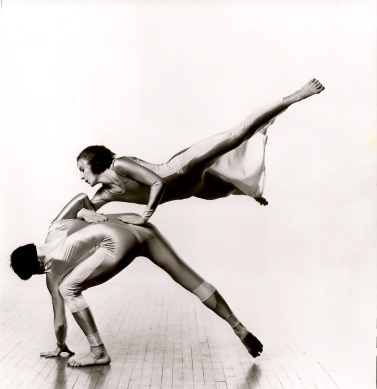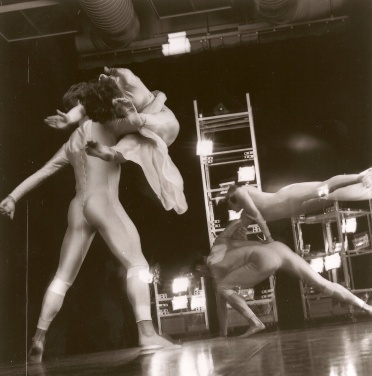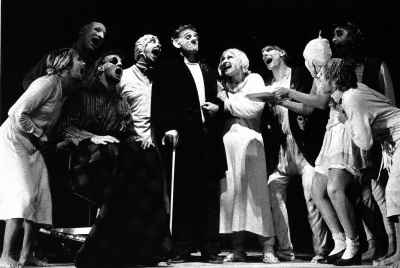 The 33rd edition of the prestigious International Dance Festival Montpellier Danse took place in France from 22nd June till 6th July. This year’s resident choreographer was Emanuel Gat, Israeli choreographer who has acquired a great reputation in France and abroad. He created three compositions for the festival, each of which originated in a different manner.
Fresh breeze of Emanuel Gat
The first piece The Goldlandbergs was composed on Bach's Goldberg Variations and it was not particularly different from previous Gat’s abstract and pure dance pieces.
On the contrary, a different way of composing the piece Corner Études was beneficiary to his work and the audience. It was created during a week of rehearsing, with direct assistance of spectators in the rehearsal studio. The basic theme for ten dancers were the words and expressions that initially concerned the human body, then the names of the dancers, tune of the songs, timing, rhythm and tempo of motion sequences. Each of the dancers invented on the basis of a spontaneous idea their dance combinations, step variations and then from an individual concept of space everyone got into contact, dialogue and created small groups. This principle is not new, but it certainly strengthens the identity of the dancers and the whole group and intervenes directly into the ingenuity of viewers. Gradually, the audience could consistently watch how it is possible to reach the final scenic stage.
In a defined and dimly illuminated space of the Opera Berlioz giant stage the audience sat around on the floor and watched from the immediate closeness the outcome of dancers’ and Gat’s compositional solution. I think it shows that Emanuel Gat initially studied composition and conducting and he definitely brings a fresh breeze into current events. The point is that the dancers move freely and with greatness, in the author's intentions and on the scene an exciting act of energy unfolds, not entirely unlike a William Forsythe’s vocabulary.
Tribute to proven qualities
Festival director, Jean Paul Montanari, invited Trisha Brown Dance Company this year. The work of Trisha Brown, American postmodernist, influenced a whole generation of dancers and choreographers in France, especially in the 80s. Several pieces from the repertoire were presented at the festival in Montpellier, now already historically valuable pieces. This year for the first time without Trisha Brown, as her health condition gets unfortunately worse. She handed the group to her longtime dancers and assistants, Carolyn Lucas and Diane Madden.
For the world tour, which began in January this year, they staged eleven choreographies, three of which were presented on the open stage at the Théâtre Agora.
On the scene by Robert Rauschenberg and music by John Cage, longtime collaborators, there was precision and purity of original dance works. In Astral Convertible from 1989 Rauschenberg created a silvery aluminum light towers that respond to touch and can trigger the flow of Cage's music, composed for brass instruments only. As a result, everything was a bit "aluminum" and cold, but the movement remained utterly unique in its abstractness.
Girl’s solo If you couldn’t see me from 1994 with music and the scenic solution by Robert Rauschenberg changed the perspective on dance for many, especially in terms of the direction of action. The whole course of the dance went - against all conventions then - with the back to the audience.
I'm going to toss my arm - if you catch them they're yours, one of the last Brown’s pieces, was influenced by calligraphy and sculpture. Plasticity of movement and touch in the foreground, multiplied by the game of blowers, giant fan-like turbines, the kinetic invention leaves to be carried by the wind’s power, taking away the elusive, sometimes unfinished movement and pieces of costumes.
The festival gave tribute to Maguy Marin by restaging the work May B from 1980, with which Marin dazzled and aroused aesthetic standards then. Inspired by the texts and work of Samuel Beckett and by a direct meeting with the playwright she has created an incredibly timeless dance theater performance. At the time of origin, included in "danse theatre", the author managed to portray all daily and boundless human existential human worries with all needs - love, lust, sex, worrying about children, worrying about survival and the very existence. Maguy Marin chose archetypes –
The 33rd edition of the prestigious International Dance Festival Montpellier Danse took place in France from 22nd June till 6th July. This year’s resident choreographer was Emanuel Gat, Israeli choreographer who has acquired a great reputation in France and abroad. He created three compositions for the festival, each of which originated in a different manner.
Fresh breeze of Emanuel Gat
The first piece The Goldlandbergs was composed on Bach's Goldberg Variations and it was not particularly different from previous Gat’s abstract and pure dance pieces.
On the contrary, a different way of composing the piece Corner Études was beneficiary to his work and the audience. It was created during a week of rehearsing, with direct assistance of spectators in the rehearsal studio. The basic theme for ten dancers were the words and expressions that initially concerned the human body, then the names of the dancers, tune of the songs, timing, rhythm and tempo of motion sequences. Each of the dancers invented on the basis of a spontaneous idea their dance combinations, step variations and then from an individual concept of space everyone got into contact, dialogue and created small groups. This principle is not new, but it certainly strengthens the identity of the dancers and the whole group and intervenes directly into the ingenuity of viewers. Gradually, the audience could consistently watch how it is possible to reach the final scenic stage.
In a defined and dimly illuminated space of the Opera Berlioz giant stage the audience sat around on the floor and watched from the immediate closeness the outcome of dancers’ and Gat’s compositional solution. I think it shows that Emanuel Gat initially studied composition and conducting and he definitely brings a fresh breeze into current events. The point is that the dancers move freely and with greatness, in the author's intentions and on the scene an exciting act of energy unfolds, not entirely unlike a William Forsythe’s vocabulary.
Tribute to proven qualities
Festival director, Jean Paul Montanari, invited Trisha Brown Dance Company this year. The work of Trisha Brown, American postmodernist, influenced a whole generation of dancers and choreographers in France, especially in the 80s. Several pieces from the repertoire were presented at the festival in Montpellier, now already historically valuable pieces. This year for the first time without Trisha Brown, as her health condition gets unfortunately worse. She handed the group to her longtime dancers and assistants, Carolyn Lucas and Diane Madden.
For the world tour, which began in January this year, they staged eleven choreographies, three of which were presented on the open stage at the Théâtre Agora.
On the scene by Robert Rauschenberg and music by John Cage, longtime collaborators, there was precision and purity of original dance works. In Astral Convertible from 1989 Rauschenberg created a silvery aluminum light towers that respond to touch and can trigger the flow of Cage's music, composed for brass instruments only. As a result, everything was a bit "aluminum" and cold, but the movement remained utterly unique in its abstractness.
Girl’s solo If you couldn’t see me from 1994 with music and the scenic solution by Robert Rauschenberg changed the perspective on dance for many, especially in terms of the direction of action. The whole course of the dance went - against all conventions then - with the back to the audience.
I'm going to toss my arm - if you catch them they're yours, one of the last Brown’s pieces, was influenced by calligraphy and sculpture. Plasticity of movement and touch in the foreground, multiplied by the game of blowers, giant fan-like turbines, the kinetic invention leaves to be carried by the wind’s power, taking away the elusive, sometimes unfinished movement and pieces of costumes.
The festival gave tribute to Maguy Marin by restaging the work May B from 1980, with which Marin dazzled and aroused aesthetic standards then. Inspired by the texts and work of Samuel Beckett and by a direct meeting with the playwright she has created an incredibly timeless dance theater performance. At the time of origin, included in "danse theatre", the author managed to portray all daily and boundless human existential human worries with all needs - love, lust, sex, worrying about children, worrying about survival and the very existence. Maguy Marin chose archetypes – waxworks of various characters - a fat woman, a distorted girl, a hunchback, a miser, a woman and a young man, anxious folks, dragged by a perpetual migration and movement, by uncertainties of various situations, hazards of war. Fears of loneliness, isolation and abandonment are underlined by Schubert melancholy music.
May B became an exemplary textbook work, not only for choreographers, but also for the general theatre public. It guested worldwide and has had countless of reruns, it has been performed by several generations. Brilliant work, however, does not age!
Simon Hecquet and Sabine Prokhoris presented Elle m'avait pas tout dit ca..., a reflection influenced by the performance of Maguy Marin. Sabine Prokhoris chose texts that directly or indirectly relate with the situations and expressions from the above-mentioned performance. Entirely in their own way they comment on the piece along with three dancers.
Current topics in need of a director
Israel Galván is one of the top flamenco dancers. He had inherited all the virtuoso equipment from his parents. However he intentionally turns away from the traditional flamenco, looking for his specific expression. On the threshold of dramatic expression and some elements of contemporary dance he tries to find his own handwriting. After a couple of very good performances this year, he is trying to cope with the problems of the Roma genocide, persecution of Gypsy minorities during the war and in the present. The topic is still current and controversial but lacks dramaturgical structure of the story in the new piece Lo Réal.
waxworks of various characters - a fat woman, a distorted girl, a hunchback, a miser, a woman and a young man, anxious folks, dragged by a perpetual migration and movement, by uncertainties of various situations, hazards of war. Fears of loneliness, isolation and abandonment are underlined by Schubert melancholy music.
May B became an exemplary textbook work, not only for choreographers, but also for the general theatre public. It guested worldwide and has had countless of reruns, it has been performed by several generations. Brilliant work, however, does not age!
Simon Hecquet and Sabine Prokhoris presented Elle m'avait pas tout dit ca..., a reflection influenced by the performance of Maguy Marin. Sabine Prokhoris chose texts that directly or indirectly relate with the situations and expressions from the above-mentioned performance. Entirely in their own way they comment on the piece along with three dancers.
Current topics in need of a director
Israel Galván is one of the top flamenco dancers. He had inherited all the virtuoso equipment from his parents. However he intentionally turns away from the traditional flamenco, looking for his specific expression. On the threshold of dramatic expression and some elements of contemporary dance he tries to find his own handwriting. After a couple of very good performances this year, he is trying to cope with the problems of the Roma genocide, persecution of Gypsy minorities during the war and in the present. The topic is still current and controversial but lacks dramaturgical structure of the story in the new piece Lo Réal. Galván wonderfully expresses with all the means of expression and dance, including the zapateado, the torture, suffering, persecution and the tragic killing of human beings, whether they are of any religion or skin color. Almost two-hour performance is lead by dancers Belén Maya, Isabel Bayón and the whole music band of the famous Pedro G. Romero. Musical compositions with all more or less typical instruments and singing, however, lead too much into the typ
 ical separation of numbers, with dance and solos alternating with musicians, in the presence of everyone involved on the stage. This entire structure of the show remains to be a Spanish flamenco show, which should be watched more by Galván as an author. Suffering, which he wants to point out, is losing its power against the entire Spanish equipage, even though Galván himself is an incredibly strong personality who could dominate the huge stage of Opera Berlioz without any additional components.
Africans Boyzie Cekwana from South Africa and Panaibra Gabriel Canda from Mozambique move in another world. No wrap of fame accompanies them. They also want to agitate against injustice and war crimes, with a completely different primitive means of expression. The Inkomati dis cord expresses originally a first agreement (the title is after the river Inkomati), which forms the territorial borders of the countries in the political pressure of apartheid of the 80s. Dancers-actors comment on the consequences of a breach of this agreement and criticize and caricature political figures using large masks.
There was an exciting performance by a handicapped dancer without legs, who epitomized the permanent consequences of forever-unsolved events.
ical separation of numbers, with dance and solos alternating with musicians, in the presence of everyone involved on the stage. This entire structure of the show remains to be a Spanish flamenco show, which should be watched more by Galván as an author. Suffering, which he wants to point out, is losing its power against the entire Spanish equipage, even though Galván himself is an incredibly strong personality who could dominate the huge stage of Opera Berlioz without any additional components.
Africans Boyzie Cekwana from South Africa and Panaibra Gabriel Canda from Mozambique move in another world. No wrap of fame accompanies them. They also want to agitate against injustice and war crimes, with a completely different primitive means of expression. The Inkomati dis cord expresses originally a first agreement (the title is after the river Inkomati), which forms the territorial borders of the countries in the political pressure of apartheid of the 80s. Dancers-actors comment on the consequences of a breach of this agreement and criticize and caricature political figures using large masks.
There was an exciting performance by a handicapped dancer without legs, who epitomized the permanent consequences of forever-unsolved events.



